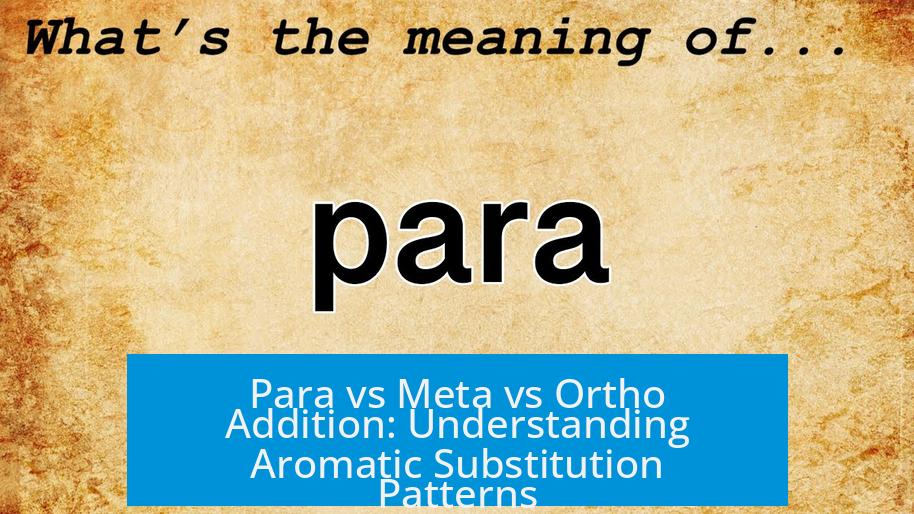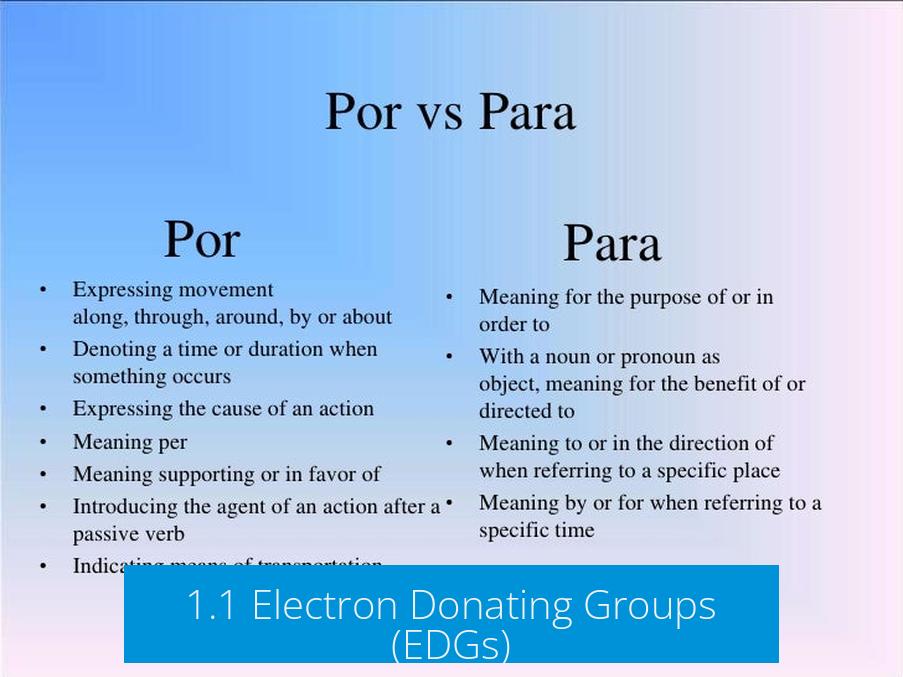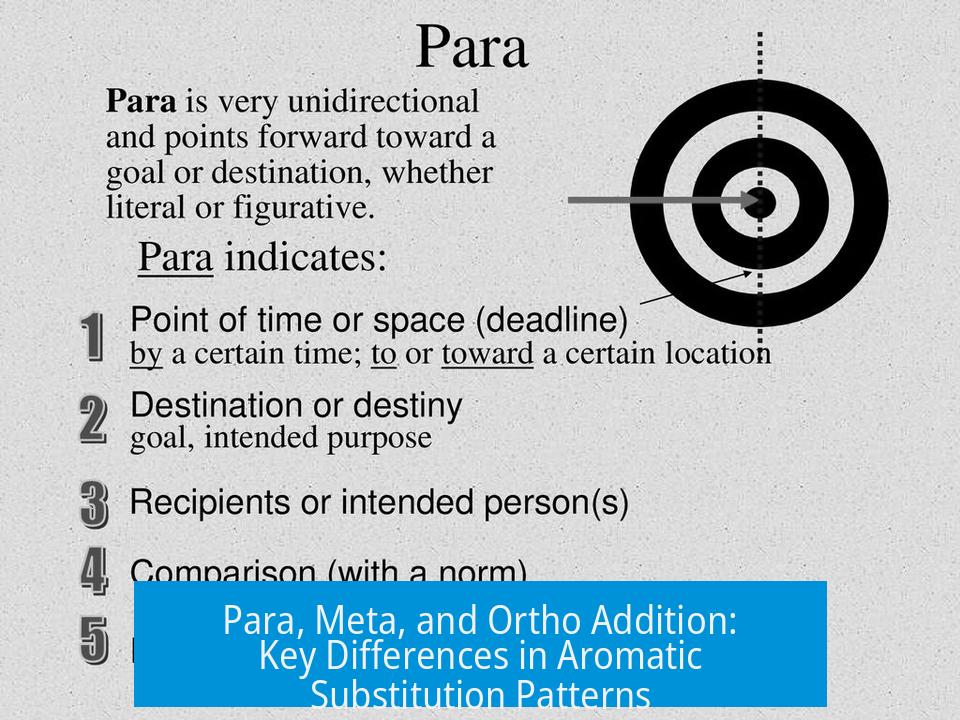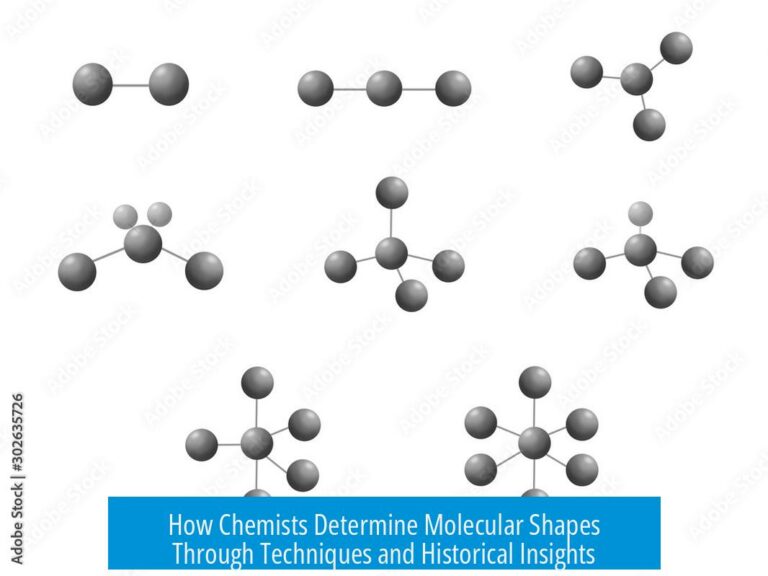Para vs Meta vs Ortho Addition: Understanding Aromatic Substitution Patterns

Para, meta, and ortho addition describe the possible positions where substituents attach to a benzene ring during electrophilic aromatic substitution reactions. The relative positions depend mainly on the electronic nature of the substituents already present on the ring, which direct incoming groups to specific locations.
Basic Concepts of Aromatic Substitution Positions
A benzene ring has six carbon atoms forming a hexagonal planar structure. The substituent already attached influences where a new group will add. The three possible relative positions are:
- Ortho: Directly adjacent carbons to the substituent (positions 2 and 6)
- Meta: One carbon removed from the substituent (positions 3 and 5)
- Para: Opposite carbon on the ring (position 4)
The position chosen during substitution depends on the electronic effects of the existing groups, which can be broadly categorized as either electron donating or electron withdrawing.
1. Electronic Effects on Directing Groups
1.1 Electron Donating Groups (EDGs)

Electron donating groups increase electron density in the aromatic ring. Common EDGs include alkyl groups (-CH3, -C2H5), hydroxyl (-OH), amino (-NH2), and alkoxy (-OCH3) groups.
These groups tend to direct incoming electrophiles toward the ortho and para positions. This happens because EDGs stabilize the carbocation intermediate formed during substitution at these positions through resonance or hyperconjugation.
- In cases such as isopropylbenzene, the alkyl group donates electrons via hyperconjugation.
- When nitration is performed on isopropylbenzene, the nitro group attaches preferentially at the para position, as steric hindrance at the ortho position makes para more favorable.
- The steric hindrance influences whether ortho or para position wins priority, but both sites remain electronically favored.
1.2 Electron Withdrawing Groups (EWGs)
Electron withdrawing groups reduce electron density on the aromatic ring, particularly at the ortho and para positions. Typical EWGs include carbonyl-containing groups like aldehydes, ketones (acyl groups), nitro (-NO2), and sulfonyl (-SO3H).
These groups direct incoming electrophiles to the meta positions because the ortho and para carbons bear reduced electron density, making formation of carbocation intermediates there less favorable.
- For example, acetophenone contains a ketone functional group that withdraws electrons.
- During bromination of acetophenone, the bromine attaches meta to the acyl substituent.
- This meta directing effect results from the reduced electron density and destabilization of carbocation intermediates at ortho/para positions.
1.3 Special Case: Bromine
Bromine, being a halogen, has both electron withdrawing and donating attributes. It withdraws electrons via induction but donates electrons through resonance because its lone pairs can delocalize into the ring, albeit less effectively than oxygen or nitrogen due to orbital energy mismatches.
Bromine ultimately acts as an ortho/para director. This is crucial in multi-step syntheses:
- When bromine is already attached, then any new substituent added will preferentially go ortho or para to that bromine.
- Its directing effect is more nuanced, as the resonance donation is limited because bromine’s 4p orbitals do not overlap strongly with carbon’s 2p orbitals.
- Despite its electron withdrawing nature, bromine directs at ortho/para positions due to the balance of resonance effects.
2. Determining Regioselectivity in Substitution

The regioselectivity of aromatic substitution largely depends on the substituents already present on the benzene ring before any reaction occurs. The incoming substituent’s nature has a lesser effect on substitution position.
Consider these points:
- The electronic effect of the existing substituent controls the stability of intermediates.
- Substituents may possess combined steric and electronic influences, modifying the exact position (endo vs exo ortho/para).
- Competition between steric hindrance and electronic preference may occur. The site of least steric hindrance is often favored.
3. Practical Examples and Reaction Types
3.1 Friedel Crafts Alkylation Followed by Nitration
Consider the synthesis where a benzene ring first undergoes Friedel-Crafts alkylation, then nitration:
- Alkylation: 2-chloropropane and aluminum chloride (AlCl3) add an isopropyl group (an alkyl group) to benzene.
- Nitration: The ring is subjected to nitration with nitric acid and sulfuric acid.
The alkyl group is an electron donating substituent. It directs the incoming nitro group preferentially to para and ortho positions.
Steric effects cause para substitution to dominate, as the ortho sites are sterically hindered by the bulky alkyl group.
3.2 Friedel Crafts Acylation Followed by Bromination

Another example uses Friedel-Crafts acylation to introduce an acyl substituent onto benzene, then brominates it:
- Acylation: An acyl chloride reacts with benzene in the presence of AlCl3, introducing the carbonyl-containing group.
- Bromination: Electrophilic substitution with bromine.
The acyl group withdraws electrons, decreasing electron density at ortho and para positions.
Consequently, bromine adds preferentially at the meta positions relative to the acyl substituent.
4. Conceptual Understanding Using Lewis Structures
Drawing Lewis structures of the benzene ring with substituents clarifies directing effects.
- Electron donating groups stabilize positive charges formed during substitution at ortho and para carbons through resonance or hyperconjugation.
- Electron withdrawing groups destabilize positive charges at ortho and para positions, so intermediates form more readily at meta carbons.
- Careful resonance structures show charge distributions that visualize why electrophiles favor particular positions.
Analyzing resonance contributors helps predict reaction sites based on where positive charges can be delocalized.
Summary Table: Directing Effects in Electrophilic Aromatic Substitution
| Substituent Type | Example Groups | Directing Effect | Reason |
|---|---|---|---|
| Electron Donating Groups (EDGs) | Alkyl (-CH3), -OH, -OCH3, -NH2 | Ortho and Para | Increase electron density; stabilize carbocation intermediate at ortho/para via resonance/hyperconjugation |
| Electron Withdrawing Groups (EWGs) | Carbonyls (C=O), -NO2, -SO3H | Meta | Lower electron density at ortho/para; destabilize carbocation intermediate, so meta favored |
| Halogens (e.g., Br, Cl) | Br, Cl | Ortho and Para | Electron withdrawing by induction but donate by resonance; overall ortho/para director |
Key Principles

- The pre-existing substituent guides the electrophile’s position during addition—this overrides the nature of the incoming substituent.
- Electron donating substituents guide substitution to the ortho and para positions.
- Electron withdrawing substituents direct new groups meta.
- Bromine and other halogens are special cases: despite being electron withdrawing, they direct ortho/para.
- Steric hindrance modifies which favored site (ortho or para) is utilized.
Conclusion
Understanding para, meta, and ortho addition hinges on evaluating the electronic nature of substituents already attached to the aromatic ring. Electron donating groups favor ortho and para substitution by stabilizing intermediates at those sites. Electron withdrawing groups reduce electron density at ortho and para positions, favoring meta substitution.
Bromine’s unique positioning as an ortho/para director stems from its ability to donate electron density by resonance despite overall electron withdrawing effects.
In applied scenarios like Friedel-Crafts alkylation, acylation, nitration, and halogenation reactions, these principles dictate regiochemistry. Drawing resonance structures further aids in predicting substitution patterns.
Key Takeaways
- Electron donating groups direct new substituents to ortho/para positions.
- Electron withdrawing groups direct substitution to the meta position.
- Bromine and halogens generally direct ortho/para due to resonance effects.
- Regioselectivity is controlled by substituents on the original aromatic ring.
- Steric hindrance influences whether ortho or para sites are favored.
Para vs Meta vs Ortho Addition: What’s the Deal?

Para, meta, and ortho addition describe where new groups attach on a benzene ring during substitution reactions, influenced mainly by existing substituents. Electron donating groups (EDGs) favor ortho and para positions, while electron withdrawing groups (EWGs) steer newcomers to the meta spot. It sounds simple, but the dance of electrons and sterics makes it rather fascinating.
So, what exactly makes a group an ortho/para director or a meta director? And why does bromine straddle both camps?
Let’s embark on this aromatic journey armed with facts and reactions that clarify the competing influences on benzene rings. This article unwraps the mystery behind para vs meta vs ortho addition with insights from electronic effects, regioselectivity, and practical chemistry examples.
Electron Donating Groups (EDGs): The Ortho/Para Fans
Imagine a benzene ring with an alkyl group like isopropyl—a proud electron donor. These alkyl groups push electron density into the ring, making it more reactive at ortho (adjacent) and para (opposite) positions.
- EDGs activate the ring for substitution at ortho or para sites.
- When sterics come into play, para substitution often wins because it avoids bumping into the bulky alkyl group.
- For example, after adding an isopropyl group via Friedel-Crafts alkylation, nitration tends to occur para to the alkyl group. It’s all about the least steric hindrance—nature’s way of playing nice.
This means the original substituent already labels the ‘VIP sections’ on the benzene dance floor for newcomers.
Electron Withdrawing Groups (EWGs): Meta’s Best Friends
On the flip side, EWGs like carbonyl groups (e.g., ketones, acyl groups) siphon electron density away from the ring. This makes the ortho and para positions less electron-rich and therefore less inviting to electrophilic attack.
- EWGs tend to steer new groups toward the meta position.
- Take acetophenone: after a Friedel-Crafts acylation adds the ketone, subsequent bromination occurs meta to it.
- The lowered electron density at ortho and para positions repels substitution there.
It’s as if the ring says, “Meta it is, friend! Stay a bit farther from me.”
That Sometimes Confusing Bromine: Ortho/Para or Meta?
Bromine is a curious case. Though it’s an electron withdrawing halogen, it acts like an ortho/para director. Why the paradox?
- Bromine’s lone pairs can delocalize into the benzene ring, but its energy mismatch (carbon 2p vs bromine 4p orbitals) limits resonance efficiency.
- This results in bromine’s directing power leaning toward ortho and para, despite being slightly electron withdrawing.
- In reactions, any group added after bromine tends to occupy ortho and para positions relative to bromine.
But don’t get tangled—this directing role depends on what’s originally on the ring. The incoming substituent’s nature matters less than the resident groups already installed.
How Do We Predict the Position? Drawing Lewis Structures Helps!
When in doubt, chemists sketch Lewis structures or resonance forms. This reveals where positive charges form in intermediates during substitution.
- For EDGs, resonance stabilization of the intermediate carbocation at ortho/para sites is possible.
- For EWGs, resonance structures placing positive charge on the ortho/para carbons are destabilized.
- Meta positions avoid such destabilization, explaining why electrophiles attack there.
That’s the secret behind the smiles and zig-zags in organic chemistry textbooks.
Real Chemistry: Friedel-Crafts Steps Up to Showcase Directing Effects
Think of the Friedel-Crafts reactions as a stage for this drama:
- Alkylation with 2-chloropropane and AlCl3 introduces an isopropyl group (an EDG) to benzene.
- Nitration using HNO3 and H2SO4 follows. The nitro group attaches para to isopropyl because ortho is too crowded.
- Acylation using an acyl chloride and AlCl3 adds a carbonyl group (an EWG).
- Bromination then prefers the meta position relative to the acyl substituent.
These cases exemplify how substituents direct traffic on the benzene ring—electron donating groups befriend ortho and para; electron withdrawing groups nudge strangers to meta.
Summary Table: Quick Guide to Directing Groups
| Type | Examples | Directing Position | Reason |
|---|---|---|---|
| Electron Donating Group (EDG) | Alkyl (isopropyl), –OH, –OCH3 | Ortho/Para | Increase electron density, stabilize carbocation intermediates |
| Electron Withdrawing Group (EWG) | Carbonyls (ketone, acyl), –NO2 | Meta | Decrease electron density at ortho/para positions |
| Halogen (e.g. Br) | –Br, –Cl | Ortho/Para (complex) | Electron withdrawing but resonance donation favors ortho/para |
Real-World Tip: Identify the Director Already on the Ring!
Here’s a critical takeaway: when predicting regioselectivity, inspect the existing substituents on benzene first. The incoming group’s identity is less important than the resident director’s influence.
For example, a benzene ring already sporting a bromine will direct new groups ortho and para to it, even if the new group itself is electron withdrawing or donating.
Why Should You Care About Para vs Meta vs Ortho?
Understanding these directing effects makes you a smarter chemist—whether you’re synthesizing pharmaceuticals or materials. It helps plan multi-step syntheses so groups land where you want. This prevents costly surprises, saves time, and speeds discovery.
Plus, appreciating these subtle electronic battles deepens your respect for the elegance of organic chemistry. Next time you see a benzene ring, you’ll read it like a map—each substituent telling you where the next guest will arrive.
Final Thoughts
Para, meta, and ortho terms describe more than just locations on a benzene ring. They reflect an underlying war between electron donating and withdrawing groups battling for control over regioselectivity.
Electron donating groups shout “Ortho and Para, come on over!” while electron withdrawing groups mumble, “Let’s keep it Meta, away from trouble.” Bromine plays the wise wildcard, supporting ortho/para despite being a halogen.
By recognizing these patterns and using tools like Lewis structures, chemists predict substitution patterns and design efficient syntheses. So, the next time your molecules start juggling groups, remember who’s the director on the ring calling the shots.
What determines if a substituent directs to ortho, meta, or para positions?
The nature of the substituent on the benzene ring is key. Electron donating groups direct new groups to ortho and para positions, while electron withdrawing groups direct to the meta position.
Why do electron withdrawing groups favor meta substitution?
They reduce electron density at the ortho and para positions. This makes these sites less reactive, so new groups add at the meta position where electron density is relatively higher.
How does steric hindrance affect ortho and para directing groups?
When steric hindrance is high at the ortho position, para substitution is preferred. For example, bulky alkyl groups will direct incoming substituents to the less crowded para position.
What is special about bromine’s directing effect?
Bromine is electron withdrawing but directs electrophiles to ortho and para positions. This happens because its lone pair can donate electrons via resonance despite its withdrawing nature.
Does the incoming substituent affect the substitution position?
No. The regiochemistry depends on groups already attached to the benzene ring. The properties of the substituents already present determine where new groups add.





Leave a Comment